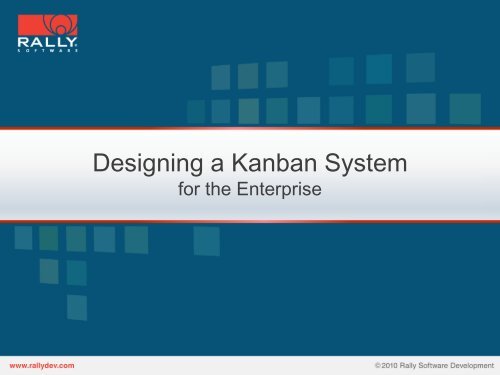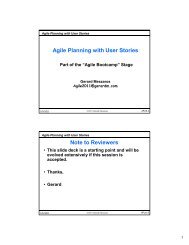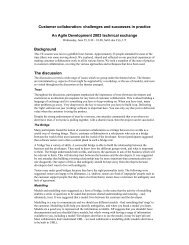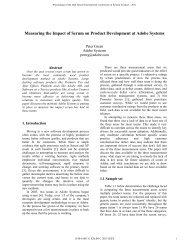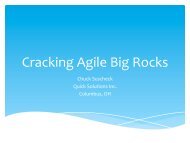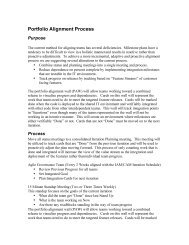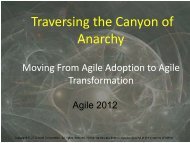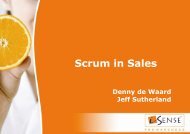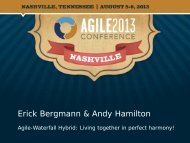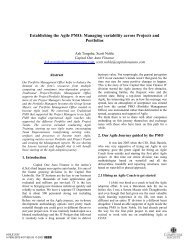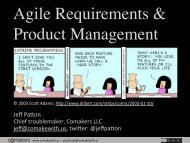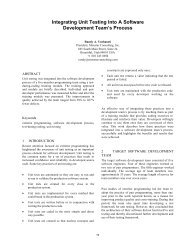Designing a Kanban System - Agile Alliance
Designing a Kanban System - Agile Alliance
Designing a Kanban System - Agile Alliance
Create successful ePaper yourself
Turn your PDF publications into a flip-book with our unique Google optimized e-Paper software.
<strong>Designing</strong> a <strong>Kanban</strong> <strong>System</strong><br />
for the Enterprise
KARL<br />
SCOTLAND<br />
kscotland@rallydev.com<br />
http://availagility.co.uk<br />
twitter.com/kjscotland
What Is <strong>Kanban</strong>?<br />
1. Workflow Tool<br />
2. Quantitative Management Approach<br />
3. Statistical Change Management Method<br />
4. Meta-Language for Process Improvement
Study<br />
Learn<br />
Enterprise<br />
<strong>Kanban</strong><br />
<strong>System</strong><br />
Envisage<br />
Sense<br />
Limit
Study: Flow<br />
Incubate<br />
Illustrate<br />
Instantiate<br />
Demonstrate<br />
Liquidate
Study: Work<br />
Demand:<br />
value,<br />
failure<br />
Work:<br />
transformation,<br />
Information<br />
A B C D E<br />
Co-ordination:<br />
feedback,<br />
expand/collapse<br />
Delays: queues,<br />
batches, handoffs,<br />
decisions
Study: Exercise<br />
• On the Study worksheet, write down an<br />
example of each type of workflow element.<br />
• Try to come up with at least one of each.<br />
• If possible, identify up to three.<br />
• Compare and contrast with your table<br />
group.
Envisage: Flow
Envisage: Work
Envisage: Exercise<br />
Dimensions<br />
• Scope<br />
• Time<br />
• Quality<br />
• People<br />
• Demand<br />
• Value<br />
• Priority<br />
• Status<br />
• Issues<br />
• Risks<br />
• Constraints<br />
• Dependencies<br />
• Assumptions<br />
Patterns<br />
• Size<br />
• Colour<br />
• Shape<br />
• Format<br />
• Location<br />
• Alignment<br />
• Rotation<br />
• Material<br />
• Texture<br />
• Graphic<br />
• Annotation<br />
• Linkage
Limit: Pull<br />
3 2 2 4
Limit: Pull<br />
3 2 2 4
Limit: Swarm<br />
Constraint<br />
5 2 2 4
Limit: Finish<br />
5 2 2 4
Limit: Exercise<br />
• 1 developer, the rest customers<br />
• Each customer wants the developer to write their name<br />
• Record<br />
– Overall Start Time<br />
– Each customer start time<br />
– Each customer end time<br />
– Overall End Time<br />
1. All Customers Together<br />
2. One Customer at a Time<br />
• Compare<br />
– Time per Customer<br />
– Overall Time<br />
http://jonjagger.blogspot.com/2010/03/henrik-knibergs-name-game.html
Sense: Cadence<br />
Prioritising<br />
Reviewing<br />
Retrospecting<br />
Releasing<br />
Features
Sense: Metrics
Sense: Crystal Properties<br />
• Frequent Delivery<br />
• Reflective Improvement<br />
• Close Communication<br />
• Personal Safety<br />
• Focus<br />
• Easy Access to Expert Users<br />
• Strong Technical Environment
Sense: Exercise<br />
Axes of Improvement<br />
• Productivity<br />
• Quality<br />
• Predictability<br />
• Responsiveness<br />
• Customer Satisfaction<br />
• Employee Satisfaction
Performance<br />
Learn: Evolve<br />
Time
Learn: Experiment
Learn: Exercise<br />
• Find a partner who is not sitting on your<br />
table.<br />
• Spend a few minutes walking and talking<br />
about an experiment you might run.<br />
• Return to your seat when you have<br />
finished.<br />
Also try A3s: http://www.crisp.se/lean/a3-template
Summary<br />
• Understand<br />
Existing<br />
Workflow<br />
Study<br />
• Visualise<br />
Work &<br />
Flow<br />
Envisage<br />
• Set WIP<br />
Limits<br />
Limit<br />
• Establish<br />
Cadence &<br />
Measures<br />
Sense<br />
• Continually<br />
Experiment<br />
& Improve<br />
Learn
Thank you!<br />
Email: kscotland@rallydev.com<br />
Twitter: http://twitter.com/kjscotland<br />
Blog: http://availagility.co.uk


